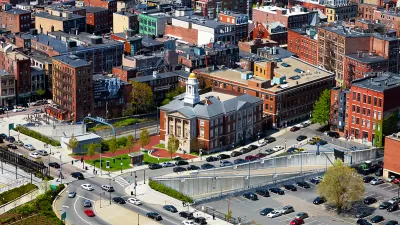Large buildings with uses of all kinds will be subject to Boston's new "Maximum Parking Ratios."

Christian MilNeil reports: "The City of Boston recently announced new planning guidelines for large developments that will limit the amount of parking that developers will be allowed to build, with stricter limits applying in the city’s most transit-accessible neighborhoods."
The city laid out the new "Maximum Parking Ratios" in a new map, with tables and a color code that matches ratios to corresponding land uses.
"In downtown, the South End, and Back Bay, where transit options are most abundant and city streets are the most congested, the new rules would limit developers to building, at most, 0.35 parking spaces per rental apartment, and 0.3 parking spaces per 1,000 square feet of office or lab space," explains MilNeil to provide some specificity on the parking ratios.
"The new maximum parking ratios only to large projects that are over 50,000 square feet in size, which is roughly the size of a 50-unit apartment building."
Differentiating these Maximum Parking Ratios from zoning reforms that remove minimum parking requirements—a more common practice in U.S. cities with every passing year—MilNeil explains that political support is building for more comprehensive parking reforms.
These Maximum Parking Ratios are a critical first step in the larger reform effort.
The Maximum Parking Ratios do accomplish reforms for minimum parking requirements, however. "Throughout the entire city, the new guidelines also specify that zero parking would be allowed for new developments, in conjunction with required 'transportation demand management' plans to provide more car-free transportation options," adds MilNeil.
FULL STORY: Boston Establishes Maximum Parking Rules for Large Developments

Alabama: Trump Terminates Settlements for Black Communities Harmed By Raw Sewage
Trump deemed the landmark civil rights agreement “illegal DEI and environmental justice policy.”

Planetizen Federal Action Tracker
A weekly monitor of how Trump’s orders and actions are impacting planners and planning in America.

The 120 Year Old Tiny Home Villages That Sheltered San Francisco’s Earthquake Refugees
More than a century ago, San Francisco mobilized to house thousands of residents displaced by the 1906 earthquake. Could their strategy offer a model for the present?

In Both Crashes and Crime, Public Transportation is Far Safer than Driving
Contrary to popular assumptions, public transportation has far lower crash and crime rates than automobile travel. For safer communities, improve and encourage transit travel.

Report: Zoning Reforms Should Complement Nashville’s Ambitious Transit Plan
Without reform, restrictive zoning codes will limit the impact of the city’s planned transit expansion and could exclude some of the residents who depend on transit the most.

Judge Orders Release of Frozen IRA, IIJA Funding
The decision is a victory for environmental groups who charged that freezing funds for critical infrastructure and disaster response programs caused “real and irreparable harm” to communities.
Urban Design for Planners 1: Software Tools
This six-course series explores essential urban design concepts using open source software and equips planners with the tools they need to participate fully in the urban design process.
Planning for Universal Design
Learn the tools for implementing Universal Design in planning regulations.
Clanton & Associates, Inc.
Jessamine County Fiscal Court
Institute for Housing and Urban Development Studies (IHS)
City of Grandview
Harvard GSD Executive Education
Toledo-Lucas County Plan Commissions
Salt Lake City
NYU Wagner Graduate School of Public Service





























